There’s a lot of extremism in the fitness world, and many people seem to think that bodyweight exercise and weight training have to be mutually exclusive. One idea out there is that bodyweight training is the “more natural” approach to fitness. While it’s true that the weight machines you see in most gyms are relatively new, the truth is people have been lifting heavy things for fitness purposes for a hell of a long time. Picking stuff up and putting it down has made people strong for centuries.
So, which is better, bodyweight exercise or weight training? The answer is neither is better. In fact, often you will get more benefit if you use both approaches together.
First Things First: Figure Out Your Goals
People are often surprised to hear that I train with weights. After all, I’m a former gymnast and martial artist. So, isn’t it kind of hypocritical for me to do weight training?
It’s really not, and here’s why: The decision to train with a particular method should be based solely on your own goals and, therefore, your own needs. I started incorporating more weight training into my fitness regimen earlier this year, when I decided I needed to fill in some gaps in my development. I’ll talk more below about how targeted weight training aids bodyweight work, but the bottom line is I adapted my training to fit my goals. So, the most important first step when choosing a training tool is to figure out what your goals are.
I actually had two goals at the beginning of 2013. One was to pack on some upper-body muscle, and one was to nail the one-arm handstand. Now, you might think these contradict each other, but they actually worked quite well together. In order to put on muscle, I started doing specialized weight training (in addition to changing my diet, of course), with a particular focus on shoulders, chest, and arms. I had to be careful to organize my training correctly so as not to interfere with my handstand progress, but I soon got into a great groove and everything clicked in place. While I spent fourteen weeks practicing the one arm handstand exclusively, the weight training I introduced spurred on further improvements in my hand-balancing skills.
And that’s just one broad example of how the combination of bodyweight training and weight training can work together to reach your goals. Here are some other examples:
- Rock Climbing – The primary skill rock climbers need to build is the bodyweight pull, but they can also use weight training as supplemental strength training for areas that are a bit neglected, such as overhead pressing and low back work.
- Jumping – If you want to improve your jumping technique, you’ll have to train the jump itself, of course, but practicing explosive weighted exercises, such as the front squat or back squat, will help you build the gross motor strength needed for the jump.
- Handstand Push Ups – As I mentioned above, it doesn’t hurt to have some good upper-body muscle mass to assist you in your hand balancing. Of course, in a freestanding handstand, you will have to constantly refine your technique and that just requires putting in the time in your handstand practice. To help you with the strength and conditioning, though, especially as you move into more difficult skills like handstand push ups, direct weight training for your rotator cuff and scapular muscles will do you a world of good.
Obviously, using bodyweight training and weight training together won’t work in all cases and for all purposes. If you want to improve your hand-balancing skills, then doing biceps curls probably isn’t going to help you achieve that. On the other hand, if your primary goal is building strong and functional muscle, using a combination of specific weighted exercise and bodyweight training could help you get there faster.
Creating a Successful Combination Program
Once you have figured out what your particular training goal is, you can decide if combining bodyweight and weighted training will be the best approach to help you reach that goal. There are many ways to create a training program, but I will give you two sample routines below to give you an idea of how to incorporate bodyweight training and weight training into a program, depending on your specific goal.
Sample Program for Hypertrophy
For this routine, I’m going to use hypertrophy as the training goal. If building pounds of muscle is a goal of yours, training with bodyweight alone is not the most efficient way to go about it. The type II muscle fibers, which are most amenable to large size increases, require significant tension and load to adapt and enlarge. This is best done through heavy progressive weight training. You can fiddle around with angles and leverages for bodyweight only training if you want, but the fastest and simplest way is through big, basic barbell and dumbbell training.
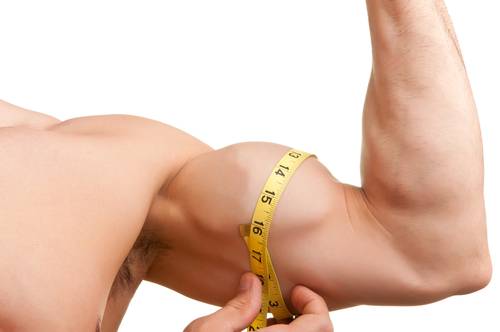
However, bodyweight training can be a great supplement to weight training for muscle growth. To hit all the bases for maximal hypertrophy, you’ll want to work on a variety of rep ranges and rest period protocols. Combining heavy lifting for lower repetitions with bodyweight exercise for moderate and high rep ranges gets that job done well.
Sample Program for Hypertrophy: Day 1
- Squats: 8 sets of 3. Increase weight to your heaviest weight on the last set. Rest 2-3 minutes between sets.
- Single leg squats: 3 sets of 10-15. Rest 60-90 seconds between sets
- Military presses: 5 sets of 5. Increase weight to your heaviest weight on the last set. Rest 2-3 minutes between sets.
- Handstand holds against the wall: 5 sets of 1-minute holds. Rest 1 minute between sets.
- Alternating dumbbell curls super-setted with tiger push ups: 3 sets of 6-8 reps for the curls and max reps for the pushups. Rest 2 minutes between sets.
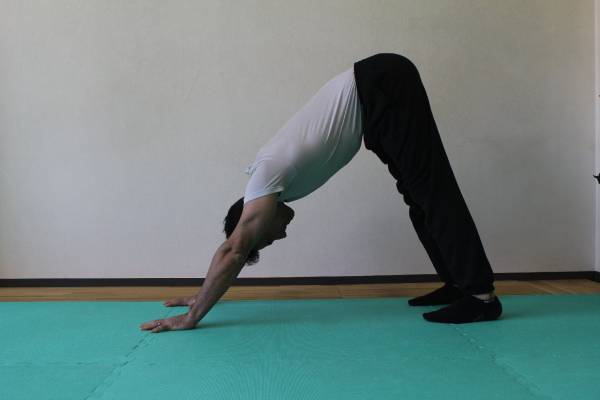
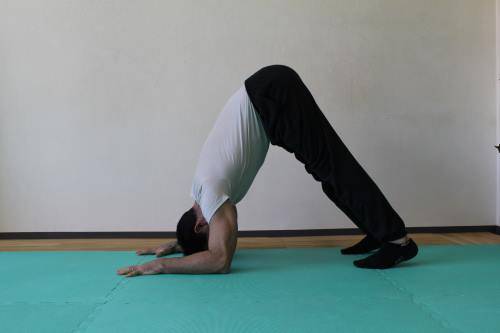
Left: Tiger push up top position; Right: Tiger push up bottom position.
Sample Program for Hypertrophy: Day 2
- Bench presses: 5 sets of 5. Increase weight to your heaviest weight on last set. Rest 2-3 minutes between sets.
- Wide grip parallette push ups: 4 sets of 12-15. Rest 1 minute between sets (pictured right).
- Weighted dips: 5 sets of 8, using the same weight for all sets. Rest 2 minutes between sets.
- Hanging leg raises, super-setting with jumps from full bottom squat position: 3 sets of 12-15. Rest 2 minutes between sets.

Sample Program for Hypertrophy: Day 3
- Deadlifts: 6 sets of 3. Increase weight to your heaviest weight on last set. Rest 3 minutes between sets.
- Chin ups: 5 sets of max reps. Rest 1 minute between sets.
- One-arm dumbbell rows, super-setted with push ups: 3 sets of 6-8 reps for the rows, and max reps for the push-ups. Rest 2 minutes between sets.
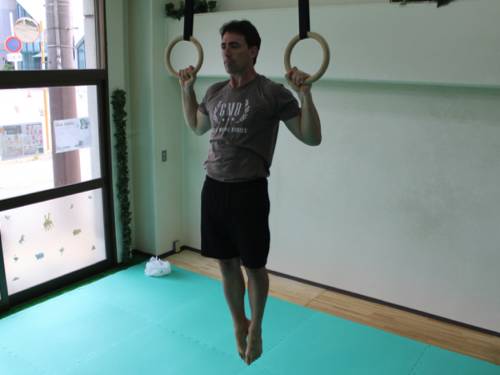
If hypertrophy is your goal, this sample program will definitely get you on the right path. Obviously you’ll need to tinker with weight loads and rest periods, but the rep ranges and order of exercises will work your muscles to the fullest.
Sample Program for Front Flips
I’m choosing the skill of front flipping as an example because it requires a good blend of power and technique. Back flips are actually not that difficult in terms of strength (and most people already have enough strength to do back flips), but it’s a matter of good instruction. Front flips, on the other hand, require great jumping ability along with fast upper-body movement. A combination of weight training and bodyweight exercises is perfect for this goal.
Sample Program for Front Flips: Day 1
- Front flip practice (as determined by qualified coach)
- Jumps from full bottom squat position to full jump with knees brought high to chest: 10 sets of 3. Rest 2-3 minutes between sets (pictured right)
- Front squats: 8 sets of 3. Increase weight to your heaviest weight on the last set. Rest 2-3 minutes between sets.
- Straight-arm pulldown: 5 sets of 5. Rest 1-2 minutes between sets.
- Frogger jumps: 3 sets of 12. Rest 1 minute between sets (pictured below)
- V-ups: 3 sets of max reps. Rest 1 minute between sets.
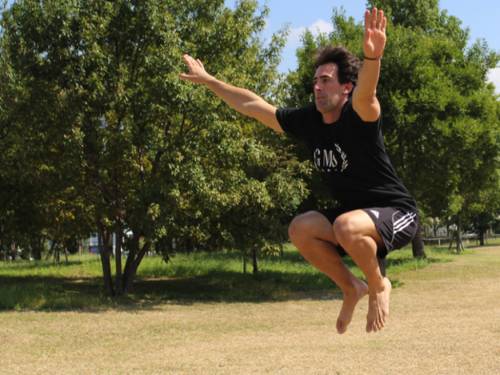
Sample Program for Front Flips: Day 2
- Front flip practice (as determined by qualified coach)
- Pull ups: 3 sets of 5 weighted pull-ups, then 2 sets of bodyweight pull-ups for max reps. Rest 2 minute between sets.
- Jumps from half squat position for maximum height: 10 sets of 3. Rest 2 minutes between sets.
- Machine calf raises: 5 sets of 12-15 reps. Rest 1 minute between sets
- Hanging leg raises: 3 sets of max reps. Rest 1 minute between sets.
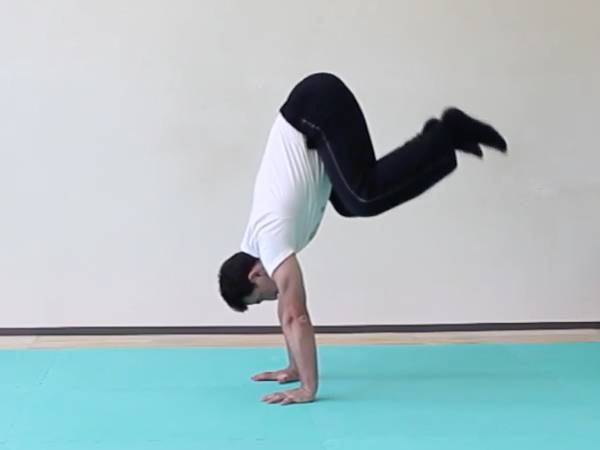
This routine combines skill practice, weight training, and bodyweight exercise to address all the areas needed for a killer front flip. Though the most important element is the skill practice under the eye of the experienced coach, the supplementary weight training and bodyweight exercises give you the specific strength work to make the most out your coaching cues.
Cycle Your Goals
What happens if you have more than one goal? Or what if your goals change? Life is cyclical, and our goals and our needs change fairly frequently. This is true of our relationships, our work, our education, and of course, our training. To head off the issue of stagnation, boredom, and plateaus with your training, we recommend using the Cycle Principle. The Cycle Principle entails sticking to a particular goal for a predetermined amount of time, then moving on to a different goal. Over the course of a year (or more), you’ll cycle through a few specific goals, coming back to those you want or need to revisit.
In this post I’ve given you a few examples of using bodyweight training and weight training together in one program, but there’s another great way to use both, and that is to cycle them. If you feel better using one modality at a time, but want to get the benefits from both, you can follow a strictly bodyweight program for a given goal and a given period of time, before moving on to a weight training program for a different goal and time period.
<em”>Photo 2 courtesy of Shutterstock.</em”>
<em”>All other photos courtesy of Ryan Hurst.</em”>






